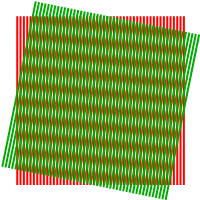 |
|
In essence, the description of moire is, an overwhelming interference of meshes, concentric rings, grids and so on that are overlaid on one another, so as to create an optical pulsation.
 |
|
https://www.sfmoma.org/watch/liz-deschenes-on-her-cameraless-photography/
 |
The effect of changing the angle of meshes. Image
|
Liz Deschenes work is all about exploiting and playing with the viewer's perceptions. This artist is playing with the experience of understanding and exploring the unintended.
Stella Baraklianou also investigates similar themes. In her recent international exhibition, in Banff, Alberta, Canada, where she was the artist in residence, Stella experimented with the properties of the material mylar, where it was used as a reflective substrate and is a sculptured reflector of both silver and gold. (This reminded me of some of the work that I have seen before by Joseph Kosuth).
Stella's enquiry was… How are these installations going to manifest themselves together with the ceramics, the tassels and the everyday objects?
By creating abstract "projected stage sets" as she called them, she was able to create new sculptures. The idea of light mirroring the piece in the centre of the stage set, changing the refraction and reflection of light to become an unknown projected object.
Clearly, there are two sides to the mylar sheets, one that stellar terms as a "cool" side and the other a "warm" side. These two sides of the mylar different effects. This has led to Stella coming up with the phrase of "Constructive Reversibles".
Stella has more recently displayed her art at the "Photography Is Magic" exhibition and also at the "Aperture Foundation" in New York in July 2016. At this event, the curator of the Photography Is Magic show was Charlotte Cotton. Further exhibits of refraction were provided by Sonja Thomsen and other artists, the website can be found here. http://aperture.org/shop/photography-is-magic-3340/
Conclusions;
- the idea of using the moire effect is an interesting concept.
- My own ideas of trying to visualise the peregrines perception could possibly incorporate the moire effect?
- Further studies into visual optics of other animals is going to be useful
- Already reading the work by Tom van Dooren entitled Flight Ways: Life and Loss at the Edge of Extinction, and in particular the symbiotic relationships that humans have with other birds, and in this book, circling vultures and mourning crows provides good reading material.
No comments:
Post a Comment